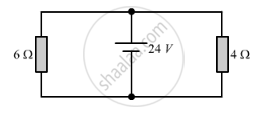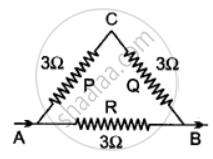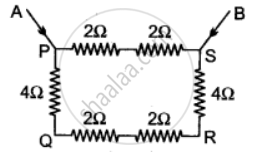Advertisements
Advertisements
प्रश्न
Find the current in each resistor in the circuit shown below:

उत्तर
In the given circuit, two 6 Ω and 4 Ω resistors are connected in parallel combination across a cell of 24 V. We know that in a parallel combination, the voltage across the resistor remains the same and only the current gets divided. So the current (I1) through the 6 Ω resistor is:
`I_1=V/R_1`
here R_1=6Ω
V=24V
so
`I_1=24/6`
`or I_1=4A
`The current (l_2) through the 4 resistors is :`
`I_2=V/R_2`
R_2=4Ω
`I=24/4`
`or I=6A`
APPEARS IN
संबंधित प्रश्न
Complete the following :-
(b)

What are the advantages of connecting electrical devices in parallel with the battery instead of connecting them in series?
Which of the following arrangement, A or B, has the lower combined resistance?

Two resistances when connected in parallel give resultant value of 2 ohm; when connected in series the value becomes 9 ohm. Calculate the value of each resistance.
How will you connect three resistors of resistances 2 Ω, 3 Ω, and 6 Ω to obtain a total resistance of 4 Ω, and 1 Ω?
If current flows through two lamps arranged:
(a) in series,
(b) in parallel,
and the filament of one lamps breaks, what happens to the other lamp? Explain your answer.
Two resistors having resistance 4𝛀 and 6𝛀 are connected in parallel. Find their equivalent resistance.
A particular resistance wire has a resistance of 3 ohm per meter. Find :
The total resistance of three lengths of this wire each 1.5 m long, in parallel.
Calculate equivalent resistance in the following cases:


You are given four ammeters A, B, C and D having the least counts mentioned below:
(I) Ammeter A with least count 0.25 A
(II) Ammeter B with least count 0.5 A
(III) Ammeter C with least count 0.05 A
(IV) Ammeter D with least count 0.1 A
Which of the ammeters would you prefer for doing an experiment to determine the equivalent resistance of two resistances most accurately, when connected in parallel?
